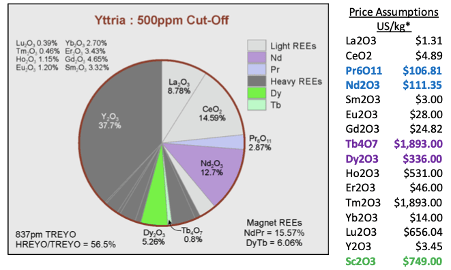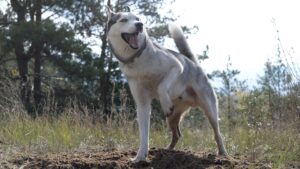Asra flags standout Rare Earths basket price of US$161/kg at Yttria

The assays showed an average 57% Heavy HREO/TREO ratio, high in valuable Dy-Tb, Pr-Nd magnet rare earth metal oxides and scandium. Pic: via Getty Images.
Asra Minerals has released the final assays from 74 RC drill holes at the Yttria regolith hosted Rare Earth Element (REE) discovery, at its Mt Stirling Project in Western Australia – confirming a high value deposit with room for expansion.
Notable Yttria REE drill intercepts include:
- 23m at 772ppm TREO from 1m: 24% HREO/TREO ratio (MSC0378);
- 17m at 516ppm TREO from 6m: 69% HREO/TREO ratio 73ppm Sc2O3 (MSC0339);
- 10m at 750ppm TREO from 8m: 59% HREO/TREO ratio 70ppm Sc2O3 (MSC0044).
Plus, new scandium oxide drill intercepts include:
- 48m at 103ppm Sc2O3 from 2m to end of hole (MSC0430);
- 38m at 96ppm Sc2O3 from 1m to end of hole (MSC0446); and
- 40m at 95ppm Sc2O3 from 1m to end of hole (MSC0450).
A full analysis of the Yttria system has unveiled the significant high-value of the REE and scandium-rich deposit, with a notable enrichment in heavy rare earth oxides, specifically the elevated Dy-Tb and Pr-Nd content.
This means Yttria has the potential to deliver a reliable source of critical rare earth metals for the supply chain of high-end magnet users, especially in the production of EV and wind turbines.
And recent REE prices demonstrate that the Yttria basket of rare earths holds an indicative basket value of US$161/kg.
This value surpasses that of most clay-hosted rare earth projects currently in their exploration stage in Australia and sets Yttria apart as a potential high value project.
Optimising REE and scandium recovery
Metallurgical testwork is now underway with the aim of determining the most effective process that will optimise the recovery of valuable REE metals and scandium from the deposit.
“We’re thrilled that these consistent near-surface results of high-value Rare Earth oxides and scandium are further raising Yttria’s potential value,” Asra Minerals (ASX:ASR) MD Rob Longley said.
“Our database now includes geochemical ratio flags enabling us to identify and prioritise ionic portions of the system for Metallurgical testwork”.
“With nearly 400 drillholes completed across Yttria on 100x50m and 50x50m centres, the data and met work will provide a very comprehensive picture of the mineralisation and we anticipate this will allow JORC classifications to be pushed up into the highest value Indicated and Measured Categories”.
“Modelling and met work are interactive and complementary processes”.
“Key parameters derived from both will greatly assist our exploration team to identify extensions of the REE horizons across Mt Stirling and our new Kookynie West project to the south.”

Room to drill test and grow
The assay results have confirmed Yttria as a Heavy-REE dominant regolith-hosted deposit over the first 2.5km strike length, with extensive areas yet to be drill tested along a further 20km strike.
Insights gained from the orebody modelling and metallurgical testwork at Yttria will be utilised to design and prioritise step out drilling along the +20km long REE corridor at Asra’s Mt Stirling Project.
While metallurgical testwork and orebody modelling is underway, the company’s exploration teams are continuing soil geochemistry and pXRF surveys at Mt Stirling to map extensions of the REE footprint.
The metallurgical testwork is expected to provide data to feed into the orebody modelling process and further sample selection for testwork.
Asra will also apply its REE leanings from Yttria to its Kookynie West Project, located 40km south of Mt Stirling.
This article was developed in collaboration with Asra Minerals, a Stockhead advertiser at the time of publishing.
This article does not constitute financial product advice. You should consider obtaining independent advice before making any financial decisions.
Related Topics

UNLOCK INSIGHTS
Discover the untold stories of emerging ASX stocks.
Daily news and expert analysis, it's free to subscribe.
By proceeding, you confirm you understand that we handle personal information in accordance with our Privacy Policy.








